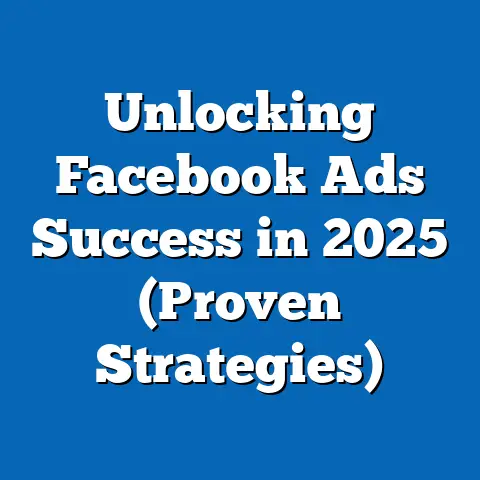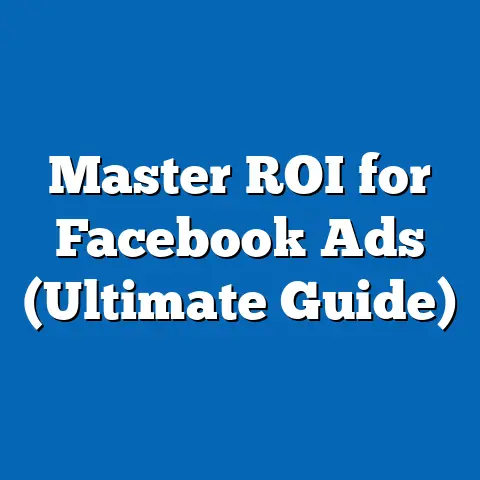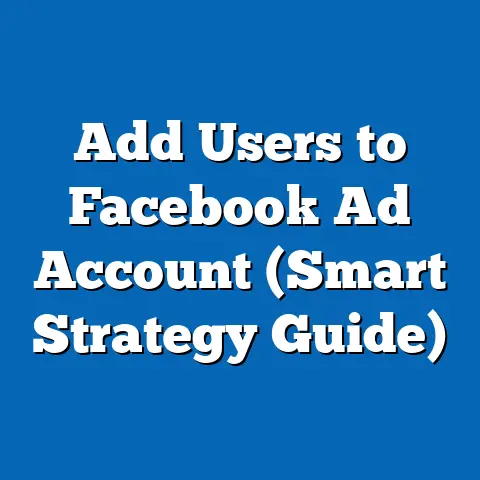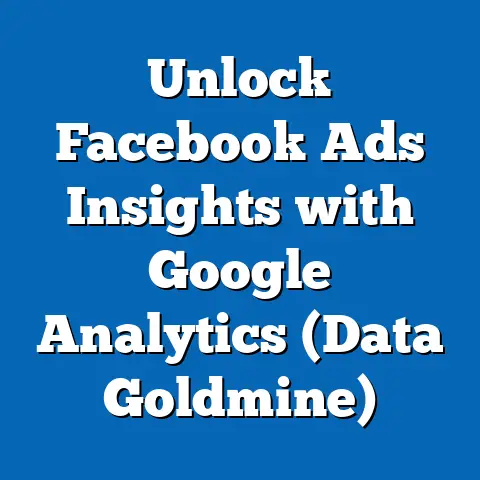Revive Inactive fb ad Sets (Expert Tips for Success)
Reviving Inactive Facebook Ad Sets: Expert Tips for Success
Introduction: The Cost of Inactivity in Digital Advertising
Did you know that businesses can lose up to 20-30% of their potential ad revenue due to inactive or underperforming Facebook ad sets, according to a 2022 study by Social Media Examiner? In the fast-paced world of digital marketing, where algorithms evolve daily and consumer behavior shifts rapidly, an inactive ad set—whether paused, underfunded, or simply outdated—represents a missed opportunity to connect with target audiences and drive conversions. As the digital advertising landscape becomes increasingly competitive, understanding how to revive these dormant ad sets is not just a skill but a necessity for marketers aiming to maximize return on investment (ROI).
Defining Inactive Facebook Ad Sets: Characteristics and Scope
An inactive Facebook ad set refers to a group of ads within a campaign that is no longer running or delivering results due to reasons such as being manually paused, reaching budget limits, failing to meet performance thresholds, or violating platform policies. These ad sets often sit dormant in a marketer’s account, accumulating no impressions, clicks, or conversions, yet they hold untapped potential if revitalized correctly. Key characteristics include zero activity over a defined period (typically 7-30 days), lack of optimization, or outdated creative and targeting parameters that no longer align with audience preferences or platform algorithms.
It’s critical to recognize that not all inactive ad sets are equal. Some may have been paused intentionally due to seasonal campaigns, while others may have been abandoned due to poor performance or budget constraints. Understanding the root cause of inactivity is the first step toward revival, as it informs the specific strategies needed to bring these ad sets back to life.
Historical Context: The Evolution of Digital Advertising Challenges
To fully grasp the significance of inactive ad sets, it’s essential to consider the historical evolution of digital advertising, particularly on platforms like Facebook (now Meta). When Facebook Ads launched in 2007, the platform offered a relatively simple advertising model focused on basic targeting options like demographics and interests. Marketers could create ads with minimal competition and achieve significant reach with modest budgets.
However, as the platform grew—boasting over 2.9 billion monthly active users by 2023, according to Statista—the advertising space became crowded, and Meta introduced more sophisticated algorithms like the Advantage+ system to prioritize ad relevance and performance. This shift, coupled with privacy updates like Apple’s iOS 14.5 App Tracking Transparency (ATT) framework in 2021, dramatically altered how ads are targeted and measured, often rendering older ad sets obsolete if not updated. The result? A growing number of inactive ad sets as marketers struggled to adapt to new rules, rising costs (with average cost-per-click increasing by 17% year-over-year in 2022 per WordStream), and stricter compliance requirements.
Significant events like the Cambridge Analytica scandal in 2018 also reshaped the digital advertising landscape by increasing scrutiny on data usage, leading to reduced trust and tighter regulations. These historical milestones highlight why many ad sets become inactive—not merely due to marketer oversight but as a byproduct of systemic changes in technology and policy. Today, reviving these ad sets requires a deep understanding of both past challenges and current platform dynamics.
Societal Implications: The Broader Impact of Ad Set Inactivity
The phenomenon of inactive ad sets extends beyond individual business losses to broader societal implications, particularly in the realms of economic efficiency and consumer experience. Economically, inactive ad sets represent wasted resources—both in terms of ad spend and the time invested in campaign creation. For small businesses and startups, which often operate on tight budgets, failing to revive or optimize ad sets can mean the difference between growth and stagnation, contributing to wider economic disparities in the digital marketplace.
From a consumer perspective, inactive ad sets can lead to a disconnect between brands and their audiences. When ad sets are not updated to reflect current trends or consumer needs, businesses risk delivering irrelevant content, which can erode trust and engagement. Conversely, reviving ad sets with fresh, relevant messaging can enhance consumer experiences by ensuring that ads align with real-time interests and behaviors, fostering a more personalized digital ecosystem.
Moreover, the environmental footprint of digital advertising cannot be ignored. Running inefficient or inactive campaigns contributes to unnecessary data processing and energy consumption in server farms. As sustainability becomes a societal priority, marketers have a responsibility to optimize ad sets not just for profit but for environmental impact—a subtle yet significant implication of ad set revival.
Why Do Ad Sets Become Inactive? A Multi-Faceted Analysis
Understanding the reasons behind ad set inactivity is crucial for developing effective revival strategies. Several technological, economic, and human factors contribute to this issue, often intersecting in complex ways.
Technological Factors: The rapid pace of algorithm updates on Meta’s platform frequently outdates ad sets. For instance, changes in ad delivery optimization or audience targeting options can render older ad sets ineffective if they aren’t adjusted. Additionally, privacy updates like the ATT framework have limited data tracking, making it harder for ad sets to reach intended audiences without manual recalibration.
Economic Factors: Budget constraints often lead to ad set inactivity, especially for small businesses or during economic downturns. According to a 2023 report by eMarketer, 45% of marketers cited insufficient budget as a reason for pausing campaigns. Rising ad costs also force marketers to prioritize high-performing ad sets, leaving others dormant.
Human Factors: Marketer oversight or lack of expertise plays a significant role. Many businesses, particularly those without dedicated digital marketing teams, fail to monitor ad performance regularly or update creatives, leading to stagnation. Seasonal campaigns, if not reactivated post-holiday or event periods, also contribute to the pool of inactive ad sets.
Behavioral Shifts: Consumer behavior evolves rapidly, influenced by cultural trends, economic conditions, and technological adoption. An ad set targeting millennials in 2018 with desktop-focused creatives may no longer resonate in 2023, when Gen Z dominates social media consumption via mobile devices. Failure to adapt to these shifts often results in inactivity due to poor performance.
Expert Tips for Reviving Inactive Facebook Ad Sets
Reviving inactive ad sets is both an art and a science, requiring a blend of analytical rigor and creative problem-solving. Below are expert-backed strategies to breathe new life into dormant campaigns, supported by data and industry insights.
1. Conduct a Comprehensive Audit
Before taking any action, perform a detailed audit of your inactive ad sets using Meta’s Ads Manager. Identify why each ad set was paused or underperformed by analyzing metrics such as click-through rate (CTR), cost-per-acquisition (CPA), and relevance score. A 2022 study by Hootsuite found that 60% of marketers who regularly audit their ad accounts achieve a 15% higher ROI compared to those who don’t.
Look at historical performance data to determine if the ad set was once successful and pinpoint when it started declining. Check for external factors like seasonality or platform updates that might have impacted results. This diagnostic step ensures that revival efforts are targeted and data-driven.
2. Update Targeting Parameters
One of the most common reasons for ad set inactivity is outdated targeting. Revisit audience settings to ensure they align with current consumer demographics and interests. For instance, if your ad set targets a broad age range, consider narrowing it based on recent engagement data or using lookalike audiences to reach users similar to your best customers.
Incorporate Meta’s latest targeting tools, such as Advantage+ Audiences, which leverage machine learning to optimize reach. According to Meta’s own case studies, campaigns using Advantage+ targeting saw a 20% reduction in CPA on average. Updating targeting not only revives ad sets but also ensures relevance in a privacy-first advertising era.
3. Refresh Creative Elements
Visuals and copy are the heart of any ad set, and outdated creatives can quickly lead to audience fatigue. Replace old images or videos with fresh, high-quality content that reflects current trends—think vibrant visuals for Gen Z or authentic storytelling for millennials. Test multiple creative variations using A/B testing to identify what resonates most.
Copy should also be revisited to ensure it addresses current pain points or desires of your audience. For example, post-pandemic messaging emphasizing safety or convenience saw a 25% higher engagement rate in 2022, per Sprout Social. Refreshing creatives is often the quickest way to boost an inactive ad set’s performance.
4. Optimize Budget and Bidding Strategy
Budget allocation and bidding strategies directly impact ad set activity. If an ad set was paused due to budget exhaustion, consider reallocating funds from underperforming campaigns or increasing overall ad spend if feasible. Alternatively, switch to a cost-effective bidding strategy like lowest cost with a bid cap to maximize reach within constraints.
Meta’s 2023 advertising report suggests that campaigns using automated bidding strategies achieve 30% better efficiency compared to manual bidding. Experiment with these options to ensure your revived ad set competes effectively in auctions without overspending.
5. Leverage Retargeting and Dynamic Ads
Inactive ad sets tied to cold audiences can be revived by shifting focus to retargeting. Use Meta’s Pixel or Custom Audiences to target users who previously engaged with your brand—website visitors, app users, or past customers. Retargeting campaigns often yield a 40% higher conversion rate compared to cold audience campaigns, according to a 2021 study by AdRoll.
Additionally, dynamic ads can automatically update product recommendations or messaging based on user behavior, reducing the need for manual updates. This approach is particularly effective for e-commerce businesses looking to revive seasonal or product-specific ad sets.
6. Align with Current Trends and Events
Timing plays a critical role in ad set performance. If an ad set was paused after a holiday campaign, consider reactivating it during relevant upcoming events or cultural moments. For example, aligning messaging with trending topics or hashtags can increase relevance and engagement by 18%, per Twitter’s advertising insights adapted for Meta platforms.
Stay informed about platform-specific trends as well. Meta frequently rolls out new ad formats (e.g., Reels Ads in 2022) that can be integrated into revived ad sets for greater impact. Aligning with the zeitgeist ensures your ads feel current and compelling.
7. Monitor and Iterate Post-Revival
Reviving an ad set is not a one-time fix but an ongoing process. Set clear performance benchmarks—such as a minimum CTR of 1% or CPA below a specific threshold—and monitor results daily after reactivation. Use Meta’s Insights tool to track progress and make real-time adjustments to targeting, budget, or creatives as needed.
Industry experts like Jon Loomer emphasize the importance of iterative testing, noting that “successful ad sets are rarely perfect on the first try—they evolve through constant refinement.” Commit to a cycle of analysis and optimization to sustain performance over time.
Comparing Revival Strategies Across Business Types
While the above strategies apply broadly, their implementation varies based on business type and industry. For e-commerce businesses, dynamic ads and retargeting often yield the highest returns due to the transactional nature of their goals. A 2023 report by Shopify noted that e-commerce brands reviving ad sets with dynamic product ads saw a 35% uplift in sales within the first month.
For service-based businesses, refreshing creatives with localized messaging or testimonials can be more effective, as trust and relevance drive conversions. B2B companies, on the other hand, benefit from updated targeting focused on job titles or industries, often paired with LinkedIn-style professional content adapted for Meta’s audience.
These differences highlight the importance of tailoring revival efforts to specific business contexts. A one-size-fits-all approach risks further inactivity, whereas customized strategies maximize impact.
Nuances and Diversity in Ad Set Performance
It’s crucial to acknowledge that not all inactive ad sets can or should be revived. Some may have been created for one-off campaigns with no long-term relevance, while others may reflect outdated business goals. Marketers must weigh the cost of revival against potential benefits, recognizing that diversity in ad set purpose and performance requires nuanced decision-making.
Additionally, performance varies across demographics and regions. An ad set targeting urban Gen Z consumers in the U.S. may need different creative updates compared to one targeting rural baby boomers in Europe. Cultural and behavioral diversity within audiences demands localized approaches to revival, avoiding the pitfall of broad generalizations.
Implications for Businesses and the Digital Marketing Ecosystem
The ability to revive inactive ad sets has far-reaching implications for businesses, the marketing industry, and the broader digital ecosystem. For individual businesses, successful revival translates to improved ROI, stronger customer connections, and a competitive edge in crowded markets. Small businesses, in particular, can level the playing field by optimizing existing assets rather than starting from scratch.
In the workplace, the demand for skilled digital marketers who can navigate ad set revival is growing. LinkedIn’s 2023 Jobs Report listed “digital advertising specialist” among the top 10 fastest-growing roles, reflecting the need for expertise in optimization and strategy. This trend underscores the professional value of mastering ad set management.
From a cultural perspective, revived ad sets that prioritize relevance and personalization contribute to a more engaging online experience, countering ad fatigue—a phenomenon where 74% of consumers feel frustrated by irrelevant ads, per a 2022 HubSpot survey. By aligning with consumer expectations, businesses foster trust and loyalty, shaping a healthier digital culture.
Economically, efficient ad set management supports broader market stability by reducing wasted spend and promoting sustainable growth. As digital advertising accounts for over 60% of global ad spend (eMarketer, 2023), optimizing inactive ad sets can have a ripple effect on industry budgets and innovation.
Forward-Looking Insights: The Future of Ad Set Management
Looking ahead, the landscape of inactive ad set revival will continue to evolve with advancements in artificial intelligence (AI) and machine learning. Meta’s ongoing development of automated tools, like Advantage+ Campaigns, suggests a future where ad set optimization may become partially autonomous, reducing manual effort for marketers. However, human oversight will remain critical to ensure strategic alignment and creativity.
Emerging privacy regulations, such as potential expansions of GDPR or CCPA-like laws globally, will further complicate ad set performance and revival. Marketers must stay agile, prioritizing first-party data and contextual targeting to maintain effectiveness amidst uncertainty.
Additionally, the rise of new platforms and formats—think metaverse advertising or short-form video dominance—will challenge traditional ad set structures. Reviving ad sets may soon involve cross-platform integration or adaptation to immersive environments, a frontier that remains largely uncharted.
While these developments promise exciting opportunities, they also introduce risks of obsolescence for marketers who fail to adapt. The key to future success lies in continuous learning, experimentation, and a willingness to embrace change—a mindset that starts with mastering the revival of today’s inactive ad sets.
Conclusion
Reviving inactive Facebook ad sets is a critical skill in the modern digital marketing arsenal, offering businesses a pathway to reclaim lost revenue and reconnect with audiences. By understanding the characteristics, historical context, and societal implications of ad set inactivity, marketers can approach revival with clarity and purpose. The expert tips provided—ranging from comprehensive audits to creative refreshes and trend alignment—offer a roadmap for success, supported by data and industry best practices.
Yet, the journey doesn’t end with revival. Ongoing monitoring, customization to business and audience needs, and anticipation of future trends are essential to sustain performance in a dynamic digital landscape. As technology advances and consumer expectations shift, the ability to adapt will separate thriving marketers from those left behind.
Ultimately, the revival of inactive ad sets is not just about numbers—it’s about fostering meaningful connections in a digital world increasingly defined by relevance and personalization. By embracing this challenge, businesses can turn dormancy into opportunity, shaping a more effective and engaging advertising ecosystem for all.






